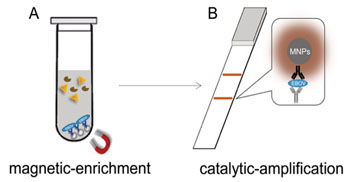Sensitive Nanozyme Test May Provide Rapid Point-of-Care Diagnosis of Ebola
By LabMedica International staff writers
Posted on 24 Sep 2015
Researchers have developed a simple low-cost Ebolavirus (EBOV) test based on detection technology using magnetic nanoparticles that has shown 100x higher sensitivity than the standard immunochromatographic ELISA gold strip test.Posted on 24 Sep 2015
In a new study led by Xiyun Yan, professor at the Institute of Biophysics, Chinese Academy of Sciences (Beijing, China), a nanozyme strip test was developed that is similar to the gold strip test but instead uses Fe3O4 magnetic nanoparticles (nanozymes) that enhance the signal via their intrinsic enzyme-like activity. Results showed 100x higher sensitivity than the gold strip test—the new test detects EBOV glycoprotein at concentrations as low as 1 nanogram/mL. Also, to concentrate the virus particles in the sample, the tube bottom is simply held against a magnet, so no expensive lab equipment is needed.

Image: In the new nanozyme immunochromatographic strip test for Ebolavirus (EBOV), the magnetic (A) and catalytic (B) properties of the nanozymes (Fe3O4 magnetic nanoparticles (MNPs)) make the signal 100 times stronger than standard strips with colloidal-gold nanoparticles, generating a deeper color reaction that can be more clearly seen by the naked eye (Image courtesy of Duan D et al., 2015, and Elsevier).
Early accurate detection is a key to controlling the Ebola outbreak as patients can then be isolated and treated. Current tests are either too expensive to be useful where they are most needed, or not sensitive enough to provide accurate diagnosis. PCR testing is highly sensitive but expensive and complicated, requiring specialized skills and equipment. Testing with the ELISA gold strip is inexpensive, but sensitivity is low.
“Our new strip test is a simple, one-step test that is cheap and easy to use, and provides a visible signal, which means people don’t need training to use it. We think it will be especially helpful in rural areas,” said Prof. Yan, “We’re very excited about our new nanozyme test, as it is much more sensitive and you don’t need any specialist equipment to get a quick, accurate result.” Her colleagues at the Chinese Center for Disease Control and Prevention (CDC) will field-test it in West Africa for its EBOV diagnostic and screening potential. The researchers are also developing automatic equipment to reduce risk of test contamination from hand-contact.
The nanozyme test is the result of an interdisciplinary collaboration of scientists and clinicians. The researchers are collaborating to develop this robust technology further as it can be applied for detection of other biological molecules, making it useful to diagnose additional infectious diseases and to potentially detect cancer tumors. It is also being tested for its potential to help in decontamination for wastewater treatment.
“We had an idea and talked to many people about it, and the result is a test that will overcome a problem,” said Prof. Yan, “We have built strong collaborations that have finally made this method successful, and we’re looking forward to applying it to many other areas.”
The study, by Duan D et al., was published online ahead of print 11 May 2015, in the journal Biosensors and Bioelectronics.
Related Links:
Chinese Academy of Sciences
Elsevier








 (3) (1).png)




